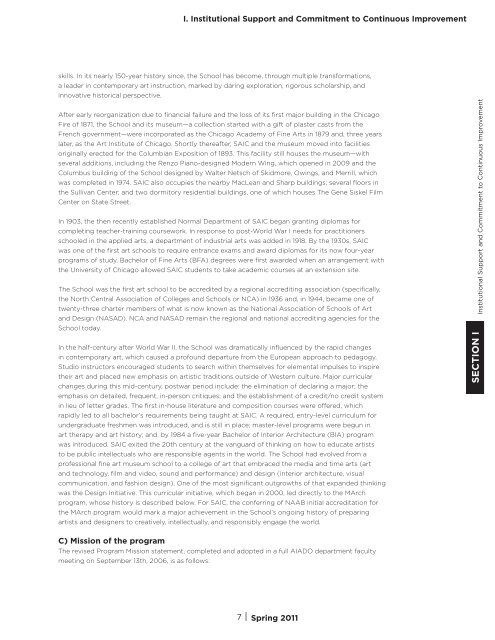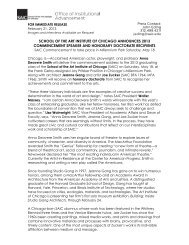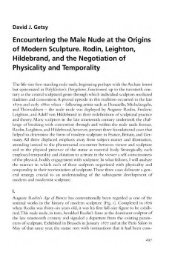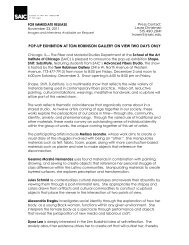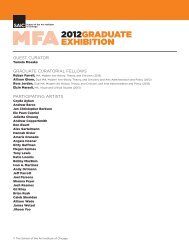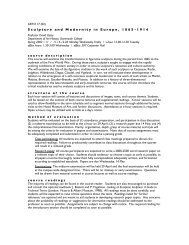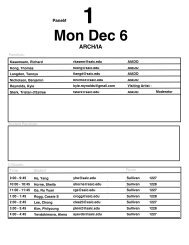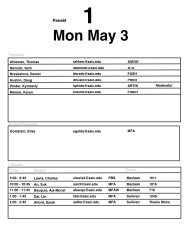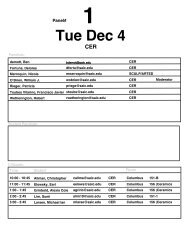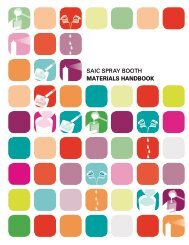i. institutional support and commitment to continuous improvement
i. institutional support and commitment to continuous improvement
i. institutional support and commitment to continuous improvement
You also want an ePaper? Increase the reach of your titles
YUMPU automatically turns print PDFs into web optimized ePapers that Google loves.
I. Institutional Support <strong>and</strong> Commitment <strong>to</strong> Continuous Improvement<br />
skills. In its nearly 150-year his<strong>to</strong>ry since, the School has become, through multiple transformations,<br />
a leader in contemporary art instruction, marked by daring exploration, rigorous scholarship, <strong>and</strong><br />
innovative his<strong>to</strong>rical perspective.<br />
After early reorganization due <strong>to</strong> financial failure <strong>and</strong> the loss of its first major building in the Chicago<br />
Fire of 1871, the School <strong>and</strong> its museum—a collection started with a gift of plaster casts from the<br />
French government—were incorporated as the Chicago Academy of Fine Arts in 1879 <strong>and</strong>, three years<br />
later, as the Art Institute of Chicago. Shortly thereafter, SAIC <strong>and</strong> the museum moved in<strong>to</strong> facilities<br />
originally erected for the Columbian Exposition of 1893. This facility still houses the museum—with<br />
several additions, including the Renzo Piano-designed Modern Wing, which opened in 2009 <strong>and</strong> the<br />
Columbus building of the School designed by Walter Netsch of Skidmore, Owings, <strong>and</strong> Merrill, which<br />
was completed in 1974. SAIC also occupies the nearby MacLean <strong>and</strong> Sharp buildings; several floors in<br />
the Sullivan Center; <strong>and</strong> two dormi<strong>to</strong>ry residential buildings, one of which houses The Gene Siskel Film<br />
Center on State Street.<br />
In 1903, the then recently established Normal Department of SAIC began granting diplomas for<br />
completing teacher-training coursework. In response <strong>to</strong> post-World War I needs for practitioners<br />
schooled in the applied arts, a department of industrial arts was added in 1918. By the 1930s, SAIC<br />
was one of the first art schools <strong>to</strong> require entrance exams <strong>and</strong> award diplomas for its now four-year<br />
programs of study. Bachelor of Fine Arts (BFA) degrees were first awarded when an arrangement with<br />
the University of Chicago allowed SAIC students <strong>to</strong> take academic courses at an extension site.<br />
The School was the first art school <strong>to</strong> be accredited by a regional accrediting association (specifically,<br />
the North Central Association of Colleges <strong>and</strong> Schools or NCA) in 1936 <strong>and</strong>, in 1944, became one of<br />
twenty-three charter members of what is now known as the National Association of Schools of Art<br />
<strong>and</strong> Design (NASAD). NCA <strong>and</strong> NASAD remain the regional <strong>and</strong> national accrediting agencies for the<br />
School <strong>to</strong>day.<br />
In the half-century after World War II, the School was dramatically influenced by the rapid changes<br />
in contemporary art, which caused a profound departure from the European approach <strong>to</strong> pedagogy.<br />
Studio instruc<strong>to</strong>rs encouraged students <strong>to</strong> search within themselves for elemental impulses <strong>to</strong> inspire<br />
their art <strong>and</strong> placed new emphasis on artistic traditions outside of Western culture. Major curricular<br />
changes during this mid-century, postwar period include: the elimination of declaring a major; the<br />
emphasis on detailed, frequent, in-person critiques; <strong>and</strong> the establishment of a credit/no credit system<br />
in lieu of letter grades. The first in-house literature <strong>and</strong> composition courses were offered, which<br />
rapidly led <strong>to</strong> all bachelor’s requirements being taught at SAIC. A required, entry-level curriculum for<br />
undergraduate freshmen was introduced, <strong>and</strong> is still in place; master-level programs were begun in<br />
art therapy <strong>and</strong> art his<strong>to</strong>ry; <strong>and</strong>, by 1984 a five-year Bachelor of Interior Architecture (BIA) program<br />
was introduced. SAIC exited the 20th century at the vanguard of thinking on how <strong>to</strong> educate artists<br />
<strong>to</strong> be public intellectuals who are responsible agents in the world. The School had evolved from a<br />
professional fine art museum school <strong>to</strong> a college of art that embraced the media <strong>and</strong> time arts (art<br />
<strong>and</strong> technology, film <strong>and</strong> video, sound <strong>and</strong> performance) <strong>and</strong> design (interior architecture, visual<br />
communication, <strong>and</strong> fashion design). One of the most significant outgrowths of that exp<strong>and</strong>ed thinking<br />
was the Design Initiative. This curricular initiative, which began in 2000, led directly <strong>to</strong> the MArch<br />
program, whose his<strong>to</strong>ry is described below. For SAIC, the conferring of NAAB initial accreditation for<br />
the MArch program would mark a major achievement in the School’s ongoing his<strong>to</strong>ry of preparing<br />
artists <strong>and</strong> designers <strong>to</strong> creatively, intellectually, <strong>and</strong> responsibly engage the world.<br />
C) Mission of the program<br />
The revised Program Mission statement, completed <strong>and</strong> adopted in a full AIADO department faculty<br />
meeting on September 13th, 2006, is as follows:<br />
7 | Spring 2011<br />
SECTION I Institutional Support <strong>and</strong> Commitment <strong>to</strong> Continuous Improvement


